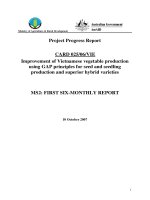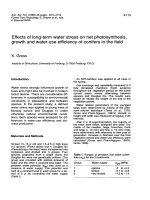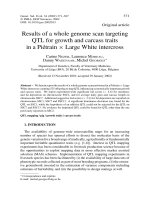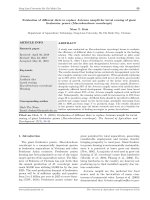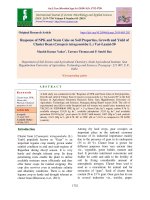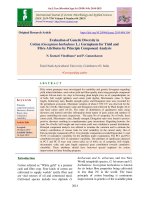Evaluation of two exotic apple varieties on M9T337 for growth and quality attributes under Kashmir conditions
Bạn đang xem bản rút gọn của tài liệu. Xem và tải ngay bản đầy đủ của tài liệu tại đây (269.91 KB, 5 trang )
Int.J.Curr.Microbiol.App.Sci (2018) 7(3): 2828-2832
International Journal of Current Microbiology and Applied Sciences
ISSN: 2319-7706 Volume 7 Number 03 (2018)
Journal homepage:
Original Research Article
/>
Evaluation of Two Exotic Apple Varieties on M9T337 for Growth and
Quality Attributes under Kashmir Conditions
Rafiya Mushtaq*, A.H. Pandit, Mohammad Tauseef Ali, Kousar Javaid,
M.K. Sharma, Amarjeet Singh and Danish Bashir
Division of Fruit Science, Sher-Kashmir University of Agricultural Science and Technology,
Kashmir, India
*Corresponding author
ABSTRACT
Keywords
Apple varieties,
M9T337, High
density, Quality,
Yield
Article Info
Accepted:
24 February 2018
Available Online:
10 March 2018
The present investigation was undertaken at experimental fields of Division of Fruit
Science, SKUAST-Kashmir, during the year 2014. In order to solve the problems of low
productivity, poor quality, less colour and irregular bearing habits in current apple
plantations in Kashmir valley, two apple varieties namely Super Chief Sandidge and Fuji
Zehn Aztec were imported from Italy on M9T337 rootstock and planted at a distance of
1.5× 3m on four wire trellis system (2222 trees/ha). Following characteristics were
recorded: tree height, TCSA, shoot length, leaf area, First flower opening, End of
flowering, fruit set, fruit leaf ratio, yield, fruit weight, L/D ratio, TSS (total soluble solids)
titrable acidity, TSS/acid ratio and juice yield. The study revealed that both the varieties
performed well under Kashmir conditions, however the variety Super Chief Sandidge
showed better performance interms of both yield and quality attributes compared to Fuji
Zehn Aztec. Fuji Zehn Aztec appeared to be more vigorous and low yielding compared to
Super Chief Sandidge.
Introduction
The apple is the most ubiquitous of temperate
fruits and has been cultivated in Europe and
Asia from antiquity.The genetic variability
found in the apple has allowed adapted types
to be selected for different environments, and
selection continues for new types to extend
apple culture in both colder and warmer
regions. Almost entire fruit plantation in the
state is on seedling origin rootstock. The
vigorous seedling rootstock leads to larger
trees, which have long juvenility. There is
more competition between vegetative growth
and fruit production within these trees and
their internal self-shading makes them more
vulnerable to various diseases (Robinson,
2003). By using vigorous rootstocks, only few
trees can be accommodated per hectare
making the productivity less profitable. With
stagnation in productivity, looming threat of
imported fruits and land prices touching new
peaks in the valley, it becomes imperative to
go for high-density plantation for which
change in rootstock from vigorous to size
controlling rootstock is a prerequisite. For the
temperate zone to prosper in apple, it is
imperative to shift to new varieties which have
2828
Int.J.Curr.Microbiol.App.Sci (2018) 7(3): 2828-2832
both high yield potential as well as good
marketability. In order to solve the problems
of low productivity, poor quality, less colour
and irregular bearing habits in current apple
plantations in Kashmir valley, two apple
varieties namely Super Chief Sandidge and
Fuji Zehn Aztec were evaluated for various
morphological and fruit characteristics at
SKUAST-K Shalimar with the objective to
study the performance of newly introduced
apple varieties for growth and quality
attributes under high density conditions.
(girth)2
Area = ---------------4π
Materials and Methods
The leaf area of each sample comprising of 30
leaves was collected at random from different
directions of each experimental tree and
measured with the help of a leaf area meter
(221 systronics) and expressed in square
centimeters.
Two exotic varieties of apple grafted on M-9
T337 rootstock were introduced by SKUASTKashmir in spring 2013 from an Italian
nursery, GRIBA, Italy. The plant material was
one year old with 3 plus feathers. The trees of
uniform size, vigour and bearing capacity
were selected for experimentation located at
Shalimar campus of SKUAST-Kashmir and
were evaluated for various growth and quality
characteristics. All the trees received uniform
cultural practices during the year under study
as per the package of practices of SKUASTKashmir. The experiment was laid in
Randomized Complete Block Design (RCBD)
with five replications and two trees per
treatment as plot size.
Shoot length (cm)
The shoots that were more than 15cm in
length were taken and shoot length was
recorded with the help of measuring tape and
expressed in centimeter.
Leaf area (cm2)
Initial bloom (DARD)
The stage was observed visually when 10 per
cent of flowers were open.
Full bloom (DARD)
The stage was observed when 80 per cent of
flowers were open.
The date of occurrence was recorded for each
tagged tree.
Growth characteristics
Fruit set (%)
Tree height (m)
The height of selected trees was measured
from the bud union to the top of tree in meters
and average value was recorded.
Tree trunk cross sectional area (cm2)
Tree trunk cross sectional area of each
experimental unit was measured 15 cm above
bud union and expressed as cm2 using
following formula:
It was calculated by using the following
formula and expressed in percentage:
No. of fruitlets at pea stage
Fruit set (%) = ------------------------------ × 100
No. of flowers
Fruit leaf ratio
The number of leaves per fruit of each
experimental unit were counted and averaged.
2829
Int.J.Curr.Microbiol.App.Sci (2018) 7(3): 2828-2832
calculated as malic acid by using the
following formula:
Yield per tree (kg)
The crop harvested from each experimental
unit was recorded and expressed in kilogram
per tree.
Quality characteristics
Titre value × normality of alkali ×
Dilution × 67
Acidity (%) = ------------------------------- × 100
Weight of sample ×
Volume of aliquot taken × 1000
Fruit weight (g)
Number of seeds/fruit
Ten fruits from each treatment in each
replication were weighed individually on a
sensitive monopan balance and average
weight was recorded in grams.
Fruits were cut and seeds removed from the
core and number was counted. Chaffy and
shriveled seeds were discarded.
L/D ratio
TSS/Acid ratio
L/D ratio was calculated by dividing the
length of fruit with the diameter of
corresponding fruit and shape of fruit was
determined as per the following procedure.
Total soluble solids/acid ratio was determined
using the formula:
L/D ratio 1 = Round; L/D ratio > 1 = Oblong;
L/D ratio < 1 = Flat
Total Soluble Solids (%)
TSS/Acidity ratio = ------------------------------Acidity (%)
Juice yield (%)
0
Total Soluble Solids ( Brix)
A hand refractrometer ranging from 0-33
(oBrix Erma make Japan) was used to
determine TSS and values were corrected at
20 oC.
Titrable acidity (%)
Acidity was determined by taking a known
weight of fruit sample (10 g) which was
crushed and added to 100 ml distilled water,
then filtered through Whatman’s No. 1 filter
paper. 10 ml of aliquot was titrated against
N/10 NaOH using phenolphthalin indicator
and end point was determined by pink
colouration. The total titrable acidity was
calculated in terms of malic acid on the basis
of 1ml of 0.1N NaOH solution equivalent to
0.0067 and expressed in terms of per cent
acidity (A.O.A.C., 1990). Acidity was
A known weight of fruit at random from each
treatment in each replication was sampled for
juice content. The seeds were extracted from
fruits and the pulp was macerated with the
help of juicer grinder. The juice was collected
in a jar and its quantity was measured in
measuring cylinder. The percent juice content
was calculated using the equation:
Volume of juice (L)
Juice per cent = --------------------------- × 100
Weight of fruit (kg)
Results and Discussion
The variety Super Chief Sandidge showed a
minimum tree height (1.31m) compared to
Fuji Zehn Aztec (1.96m). Trunk cross
sectional area was recorded more in Fuji Zehn
Aztec (4.70cm2) than Super Chief Sandidge
2830
Int.J.Curr.Microbiol.App.Sci (2018) 7(3): 2828-2832
(3.72 cm2). The overall reduced vigour of all
the trees may be attributed to the dwarfing
rootstock as the hypothesis is that dwarfing
rootstock, or possibly its graft union alters the
ratios and concentrations of the growth
promoting hormones and also the inhibiting
hormones which are translocated within the
tree (Ferree and Warrington, 2003, Micheal,
2009). Our results are supported by the
findings of Kiprijanovski et al., (2002) who
reported that the cultivar Fuji Kiku 8 had the
largest trunk cross sectional area and canopy
area at the end of the sixth year. Leaf area was
recorded maximum in Super Chief Sandidge
(43.21cm²) and minimum in Fuji Zehn Aztec
(32.65 cm²). The variation among the varieties
may be varietal or due to other environmental
factors. The leaf area is considered one of the
most important components of the fruiting
structures involved in the fruit size and quality
because branches with a large leaf area present
a higher photosynthetic capacity, reducing the
competition for photosynthates with other
branches (Costes, 2003). The first flower
opening and end of flowering was observed
earlier in Super Chief Sandidge (45.35DARD
and 57.28 DARD respectively) than Fuji Zehn
Aztec (47.85DARD and 60.36DARD). The
differences in the phenological stages may be
due to their genetic differences or the
differential chilling requirements of these
varieties may be the reason for such
variations. Fruit set percent was recorded
highest in Super Chief Sandidge (62.55%) and
lowest in Fuji Zehn Aztec (57.48%).
Our research results were in conformity with
the findings of Madial et al., (2010) who
reported that low fruit set in Fuji is due to high
amount of vegetative buds in this cultivar. It
has been suggested that there should be 30-40
leaves for the quality production of a single
fruit. However, for high density plantation this
number is relatively low which was confirmed
in our research. The highest fruit leaf ratio was
observed in variety Fuji Zehn Aztec (31.29)
while the least ratio was observed in variety in
Super Chief Sandidge (25.28), as it is highly
spur variety. The maximum average yield was
recorded
in
Super
Chief
Sandidge
(2.45kg/tree) compared to Fuji Zehn Aztec
(2.05kg/tree) (Table 1).
Table.1 Growth characteristics of two exotic varieties
Variety
Tree
Height(m)
TCSA
(cm2)
Shoot
length (cm)
Leaf area
(cm2)
1.31
3.72
89.45
1.96
4.70
0.40
0.28
Super Chief
Sandidge
Fuji
Zehn
Aztec
Cd (p≤0.05)
End of
flowering
(DARD)
57.48
Fruit set
(%)
Fruit leaf
ratio
Yield
(kg/tree)
43.21
First Flower
Opening
(DARD)
45.35
62.55
25.11
2.45
100.20
32.65
47.85
62.55
57.48
31.29
2.05
1.19
0.89
0.30
1.08
1.99
0.35
0.13
Table.2 Quality characteristics of two exotic varieties
Variety
Super Chief
Sandidge
Fuji Zehn
Aztec
Cd (p≤0.05)
Fruit
weight (g)
193.99
L/D ratio
0.87
Number of
seeds/fruit
9.60
TSS
(°Brix)
14.12
Total acidity
(%)
0.20
TSS/acid
ratio
70.34
Juice yield
(%)
70.51
157.62
0.77
7.56
12.40
0.32
39.67
67.41
33.42
0.05
1.05
0.96
0.05
5.71
0.57
2831
Int.J.Curr.Microbiol.App.Sci (2018) 7(3): 2828-2832
Fruit weight was recorded maximum in Super
Chief Sandidge (193.99g) than Fuji Zehn Aztec
(157.62g). The variation in fruit weight may be
due to varietal characters and presence of seeds
in the fertilized fruits as the fruits containing
seeds with endosperm are the sites of giberrellic
acid synthesis, where growth substances are
produced. Fuji Zehn Aztec appeared to be more
flat in shape (0.77) and Super Chief Sandidge
round (0.87).Number of seeds per fruit were
recorded maximum in Super Chief Sandidge
(9.60).According to Currie et al., (2000), a very
common pattern to express this fruit shape is the
length/diameter ratio. Our research results were
further supported by the findings of Madial et
al., (2010), who reported that Fuji produces
more flattened fruits with an average of 0.79.
Super Chief Sandidge showed high TSS (14.12
°Brix) and low acidity (0.20%) while variety
Fuji Zehn Aztec showed TSS of 12.40 °Brix
and acidity (0.32%). The TSS/acid ratio is a key
characteristics of determine the taste, texture
and feel of fruit segments. It is sugar/acid ratio
which contributes towards giving many fruits
their characteristic flavour. This ratio was found
highest in variety Super Chief Sandidge (70.34).
The variation among varieties may be due
varietal difference, environmental factors,
difference in the sugar content of varieties
(Table 2). These characters are also influenced
by climatic and moisture availability during the
growing season. According to Hudina et al.,
(2001), the applied agrotechnical and
pomotechnical measures such as fertilization,
irrigation and the training systems can influence
these parameters. The study revealed that both
the varieties performed well under Kashmir
conditions, however the variety Super Chief
Sandidge showed better performance interms of
both yield and quality attributes compared to
Fuji Zehn Aztec. It can be suggested that in
variety Super Chief Sandidge further close
plantings at the rate of 3906 trees/ha can be
recommended to utilize the inter-tree space
more efficiently and the productivity further
high.
References
A.O.A.C. 1980. Methods of Analysis; 14th ed.
Association of Official Agriculture
Chemists. Washington, D.C; USA 957.
Costes, E. 2003. Winter bud content according to
position in 3-year old branching system in
Granny Smith apple. Annuals of Botany 92:
581-588.
Currie, A.J., Ganeshanandan, S., Noiton, D.A.,
Garrick, D., Shelbourne, C.J.A. and
Oraguzie, N. 2000. Quantitative evaluation
of apple (Malus × domestica Borkh.) fruit
shape by principal component analysis of
Fourier descriptors. Euphytica 111: 219227.
Ferrec, D.C. and Warrington, I.J. 2003. Apples:
Botany, Production and Uses. CABI
Publication.
Hudina, M., Stampar, F. and Zadravec, P. 2001.
The Influence of Planting Density on Sugar
and Organic Acid Content in Apple. Acta
Horticulturae 557: 313-320.
Kiprijanovski, M., Arsov, T., Gjanovski, V. and
Damovski, K. 2002. Study of certain
introduced apple cultivars in the Prespa
region. Acta Horticulturae 825: 125-132.
Madail, R.H., Herter, F.G., Leite, G.B. and Petri,
J.L. 2010. Influence of flower structure in
the flower production and fruit set in some
apple cultivars. Acta Horticulturae 872:
309-311.
Robinson, T.L. 2003. Apple orchard planting
system. In: Apples (Eds. D.C., Ferrec and
I.J., Warrington), Cabi Publ., Wallingford,
UK. Pp: 345-407.
How to cite this article:
Rafiya Mushtaq, A.H. Pandit, Mohammad Tauseef Ali, Kousar Javaid, M.K. Sharma, Amarjeet
Singh and Danish Bashir. 2018. Evaluation of Two Exotic Apple Varieties on M9T337 for Growth
and Quality Attributes under Kashmir Conditions. Int.J.Curr.Microbiol.App.Sci. 7(03): 2828-2832.
doi: />
2832


